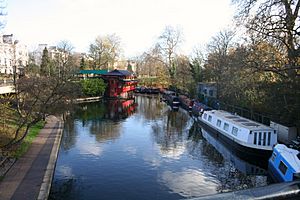Cumberland Basin (London) facts for kids
The Cumberland Basin was a special dock for boats in London, England. It was located near Euston railway station and was an important part of the Regent's Canal. This basin was sometimes called Cumberland Market Basin. In the 1880s, it was known as Jew's Harp Basin, named after a pub nearby.
Work on the basin began in 1813. It was built to serve the Cumberland Market and the busy "New Road" (now Euston Road). Later, between 1941 and 1942, the basin was filled in. This was mostly done using rubble from buildings destroyed during the London Blitz, which were heavy bombings during World War II.
The Cumberland Arm Canal
The Cumberland Arm was a stretch of canal about 1 kilometer (0.6 miles) long. It connected the Cumberland Basin to the main Regent's Canal. Today, the Regent's Canal flows through what is now the car park for the London Zoo. You can still see where the Cumberland Arm met the Regent's Canal. This spot is called the Cumberland Turn. A small part of the arm remains and is home to the Feng Shang Floating Restaurant.
Life Around the Arm
In the 1880s, an American writer named Ellis Martin visited London's canals. He decided not to go into the Cumberland Basin. An older report from the 1850s had described it as "no better than a stagnant putrid ditch." This meant the water was very dirty and still. The report also noted that a disease called cholera had spread among people living nearby and on boats.
The basin and its connected waterways were approved for building in 1813. They were meant to help transport goods to the Cumberland Market and New Road (now Euston Road). The basin officially closed in 1942.
The Arm During Wartime
In August 1938, the basin was blocked off. During the London Blitz in World War II, the Cumberland Arm became very useful. It supplied water to fire pumps that were fighting fires across London's West End. By 1941, the arm and basin were completely filled in. They were packed with rubble from buildings that had been destroyed by bombs.
What Remains Today
After World War I, the Crown Estate, which manages royal lands, started using parts of the area around Cumberland Market. They built homes for soldiers who had fought in the war. Eventually, the land right next to the Cumberland Basin was also used for these new homes, known as the Cumberland Market Estate.
You can still find some old street lamps that were once part of the basin area. They are on Gloucester Gate Bridge. This bridge goes over the main part of the Regent's Canal, just west of the Cumberland Turn.


